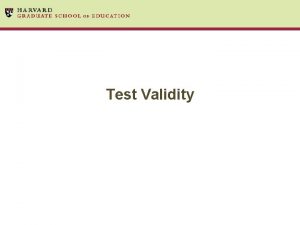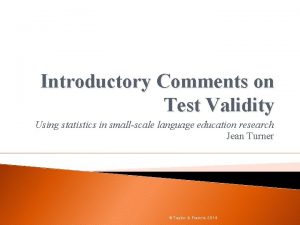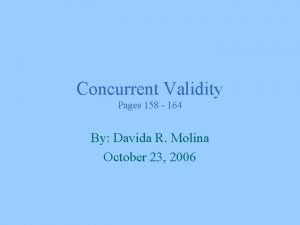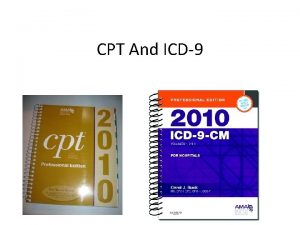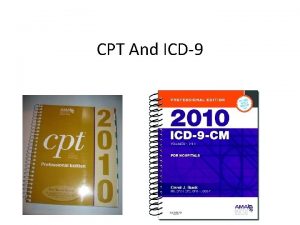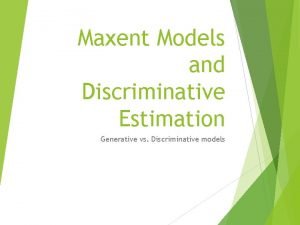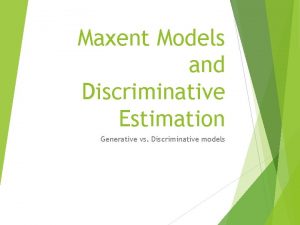Concurrent and Discriminative Validity of the CPT 3









- Slides: 9

Concurrent and Discriminative Validity of the CPT 3 and the WRAML 2 in the Assessment of ADHD Rebecca Bosley, Regan Chalk, Jenna Hennessey, & Mark Mc. Gowan

Introduction Background Attention is a multi-faceted construct that serves as a foundation for higher-level cognitive functioning (Sami et al. , 2018). Best practice models utilize a multi-dimensional approach, including direct and indirect attentional measures, to evaluate the diverse presentation of ADHD. Direct attention measures are regularly utilized to provide objective evidence of the symptomology of ADHD (Gaultieri & Johnson, 2005). Cross battery assessments measuring direct attentional performance are often warranted to adequately assess the multiple components of attention. Due to limited research, it remains unclear the role direct attention cross assessment batteries play in discriminating between clinical and non-clinical presentations of ADHD (Curewitz, 2017). Evidence Base The literature has placed an emphasis on investigating the sensitivity and specificity of indirect measures or multidimensional approaches in identifying individuals with ADHD. Limited studies have investigated how direct attention cross assessment batteries of well-known measures, like the CPT 3 and WRAML 2, contribute to discriminating between clinical and non-clinical presentations of ADHD. As a result, the role of direct attention cross batteries in diagnosing ADHD remains unclear. That said, a review of the existing literature has suggested that the CPT 3 displays strong internal consistency as well as discriminative and incremental validity. The CPT 3 has been found to improve the ability of rating scales to accurately classify group members with ADHD, especially when used in conjunction with the Conners Continuous Auditory Test of Attention (Conners, 2014). Similarly, the attention and concentration scales on the WRAML 2 have been useful in distinguishing between individuals with and without ADHD (Burton, Mittenberg, Gold, & Drabman, 1999; Mealer & Morgan, 1994; Scheffler & Kelley, 1999).

Present Study Research Questions Ø The first purpose of the study was to examine the RQ 1: concurrent validity between the assessments (CPT 3 and WRAML 2). Statistical Analyses A Pearson’s Productmoment correlational analysis was used to examine the correlations among the CPT 3 and the WRAML 2 RQ 2: Ø Another purpose of this study was to examine the diagnostic accuracy of the CPT 3 and the WRAML 2 when used in conjunction. A discriminant analysis was used to determine how well the CPT 3 and WRAML 2 could identify group membership among an ADHD population

Methods Participants: Test Parts Utilized Ø 62 students (26 males, 36 females) CPT 3 Ø Detectability Ø Omissions Ø Commissions WRAML 2 Ø Finger Windows Ø Number Letter Ø 11 -13 years (31 sixth grade, 31 seventh grade) Ø 9 with prior diagnosis of ADHD (7 males, 2 females). Procedures: Ø Utilized data from a study examining the efficacy of Cogmed Working Memory Training (CWMT) Ø Extracted from pre-intervention phase Ø Participants were administered CPT 3 and WRAML 2 before receiving CWMT

RQ 1: Concurrent Validity Table 1 Correlational Analysis of CPT 3 and WRAML 2 1. 2. 3. 4. 5. 1. CPT 3 Detectability 2. CPT 3 Omissions . 787 * 3. CPT 3 Commissions . 891 * . 475 * 4. WRAML 2 Finger Windows -. 326 -. 219 -. 297 5. WRAML 2 Number Letter . 045 . 064 . 044 . 216 Note: The significant results for the correlational analysis of the Conner’s Continuous Performance Test 3 rd Edition and the Wide Range Assessment of Memory and Learning 2 nd Edition are indicated above with an asterisk. * p. 001 Significant at <. 001

RQ 2: Discriminative Validity Table 2 Discriminant Analysis of Group Membership for Selected Measures of the CPT 3 and WRAML 2 Count Percentage ADHD DX No ADHD Total No ADHD 52 1 53 ADHD 8 1 9 No ADHD 98. 1 1. 9 100. 0 ADHD 88. 9 11. 1 100. 0 Note: The results for the discriminant analysis of the Conner’s Continuous Performance Test 3 rd Edition and the Wide Range Assessment of Memory and Learning 2 nd Edition in conjunction correctly identified 85. 5% of cases.

Discussion Although best practice recommendations suggest that a multidimensional approach be used when assessing for ADHD, most research has examined the role of indirect measures in the assessment process. There are mixed findings regarding current research that has been conducted to investigate how direct attention cross assessment batteries of well-known measures, like the CPT 3 and the WRAML 2, contribute to being able to discriminate between clinical and non-clinical presentations of ADHD. This study sought to investigate the diagnostic accuracy of the CPT 3 and the WRAML 2 in conjunction. A preliminary analysis of the concurrent validity of these assessments was also conducted. Findings suggest inadequate concurrent validity amongst the CPT 3 and WRAML 2 as only 3 out of 10 correlations were statistically significant and they only existed within the CPT 3. In addition, findings concluded that this direct attention cross battery failed to identify students who met criteria for an ADHD diagnosis in this sample. The results of the discriminant analysis indicated that the CPT 3 and the WRAML 2 were able to correctly classify 85. 5% of cases. Additionally, 98. 1% of participants without ADHD and 11. 1% with ADHD were accurately identified.

Limitations and Implications The overall sample of participants and the clinical group within the sample was small. Further, the clinical group consisted of students that were simply identified as having ADHD; the group was not further broken down by type. In addition, a small, homogeneous sample of students was used which may have impacted the ability to generalize results. The sample of participants that were identified as having ADHD were identified based off parent reports. Overall, the results suggest that the CPT 3 and the WRAML 2 are likely measuring different aspects of attention. The findings also indicate that these instruments may yield false-negative results related to the presence of ADHD, when used collectively. It remains unclear the role of direct assessment measures in the evaluation of ADHD in terms of DSM-5 behavioral symptomology. This stands to reason given the literature suggesting that rating scales are the strongest predictor of ADHD (Dvorsky, Langberg, Molitor, & Bourchtein, 2016; Du Riet et. al. , 2017; Power et al. , 1998; Simms & Lonigan, 2012). Further research is needed in assessing the utility of direct assessment batteries using a more diverse and larger sample. This study also indirectly highlights the importance of utilizing a multi-dimensional approach, i. e. , incorporating both indirect and direct assessment instruments, when assessing the symptomology of ADHD.

Contact Information Name Email Address Rebecca Bosley, M. Ed. xmzy@iup. edu Regan Chalk, M. Ed. szrv@iup. edu Jenna Hennessey, Ph. D jhenness@iup. edu Mark Mc. Gowan, Ph. D, NCSP mmcgowan@iup. edu



